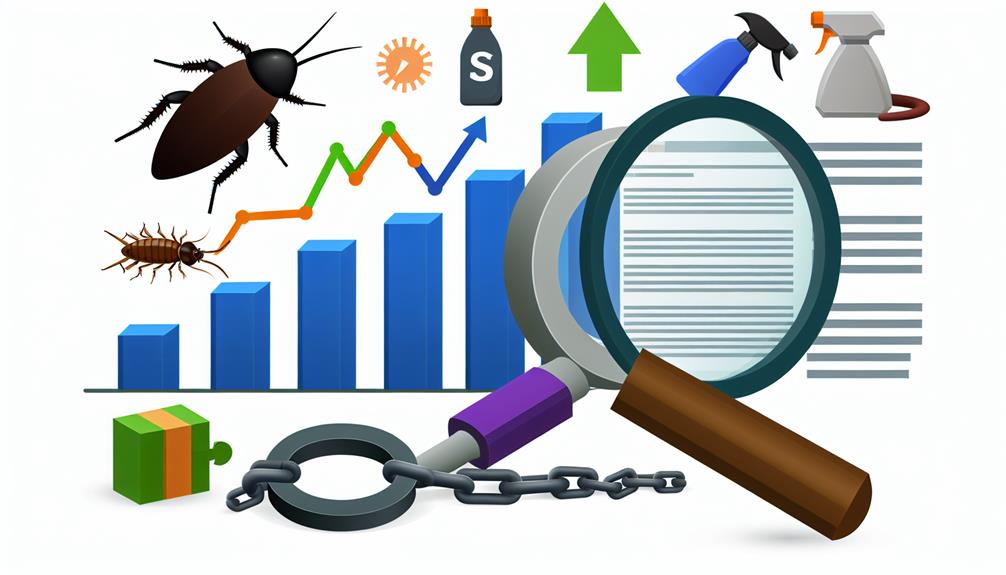Did you know that over 93% of online experiences start with a search engine? That’s why, as a pest control business owner, you can’t afford to ignore the potential of Search Engine Optimization (SEO).
It’s all about improving your website’s visibility on search engine result pages, which can significantly boost your customer base.
But what exactly are the best SEO strategies for pest control websites? Let’s uncover the most effective techniques that can help your pest control site rank higher and attract more traffic.
Table of Contents
ToggleUnderstanding SEO for Pest Control Websites

To harness the power of SEO for your pest control website, it’s crucial to grasp the nuts and bolts of search engine algorithms and how their strategic application can boost your online visibility. Understanding the SEO Basics Overview is your first step. It’s all about optimizing your site with relevant keywords, backlinks, and engaging content that will help search engines like Google recognize your site as a valuable resource.
When it comes to Pest Industry Algorithms, it’s about tailoring your SEO strategies to align with specific search trends in the pest control industry. For instance, during warmer seasons, searches for pest control may skyrocket. Your site should be ready to capitalize on that surge with SEO-optimized content relevant to the season, such as tips for preventing pest infestations during summer.
Keyword Research and Implementation
Delving into keyword research and implementation, you’ll find it’s not just about choosing popular terms, but rather strategically selecting and using phrases that your potential pest control customers are likely to use in their searches. This approach ensures you’re in tune with their needs, making it more likely for your website to appear in their search results.
An essential part of this strategy is competitor keyword analysis. By examining the keywords your competitors rank for, you’ll gain insight into what’s working for them and identify potential opportunities for your website. You might discover keywords you hadn’t considered or find gaps in their strategy that you can exploit.
Another key aspect is the utilization of long tail keywords. These are more specific phrases that may have lower search volumes, but higher conversion rates. For instance, instead of targeting ‘pest control’, you might target ‘organic pest control for gardens’. Although fewer people might search for this term, those who do are more likely to need your services and therefore convert.
In short, a strategic mix of competitor keyword analysis and long tail keywords utilization can help boost your website’s visibility and attract the right audience.
Optimizing Website Structure and Content

Having tackled keyword research, it’s crucial you frequently scrutinize and enhance your site’s structure and content for optimal SEO performance. This process involves two key areas: content readability and site navigation.
- Content Readability: Ensure your content is easy to read. Use short sentences, clear headings, and bullet points. This not only benefits your readers but also search engines, as they prefer well-structured content.
- Site Navigation: Your website should be easy to navigate. A logical, intuitive layout helps visitors and search engines understand your site. Include a sitemap to guide users and improve crawling.
- Mobile-Friendly: With a growing number of users accessing websites via mobile devices, it’s essential your site is mobile-friendly. This will improve user experience and your ranking on search engine results pages.
- Page Speed: Slow loading pages are a sure way to lose visitors. Optimize your site’s speed by compressing images, reducing server response time, and eliminating unnecessary plugins.
Leveraging Local SEO Techniques
When it comes to boosting your pest control business’s online visibility, leveraging local SEO techniques can be a game-changer, placing you right where your potential customers are searching. Local SEO capitalizes on geo targeting benefits, enabling search engines to match your business with customers in your locality. This strategic approach ensures your pest control services are displayed to the people who are most likely to need them.
Start by claiming your business on local directory listings. Sites like Google My Business, Yelp, and Bing Places offer a platform where you can list your services, contact details, and customer reviews. This not only enhances your online presence but also builds credibility for your business.
Moreover, optimize your website content and meta descriptions with local keywords. These include your city, town, or region’s name plus pest control-related terms. This reinforces your geographical relevance to search engines, propelling your site to the top of local searches.
Monitoring SEO Performance and Adjustments

While implementing SEO strategies is crucial, it’s equally important to continually monitor your website’s performance and make necessary adjustments to refine your approach. Performance analytics are key to understanding what’s working and what’s not for your pest control website.
Here’s a four-step process to effectively monitor and adjust your SEO efforts:
- Track Metrics: Regularly check your website’s traffic, bounce rate, and conversion rates. These metrics can reveal if your content resonates with your audience or if adjustments are needed.
- Study Algorithm Updates: SEO isn’t static. Search engines constantly update their algorithms, and staying abreast of these changes can help you tweak your strategies for better results.
- Analyze Competitors: Keep an eye on what your competitors are doing. They might be using tactics that you haven’t considered, which could boost your SEO performance.
- A/B Testing: Experiment with different SEO techniques. Change one element at a time to see what yields better results, and adopt those winning strategies.
Conclusion
Just like a meticulous exterminator, you need to approach SEO for your pest control website with precision and strategy.
By focusing on keyword research, optimizing your site structure and content, leveraging local SEO, and constantly monitoring and adjusting your SEO performance, you’re setting a trap that search engines can’t resist.
Remember, effective SEO is a long-term commitment, not a one-time treatment. So stay attentive, and watch your website steadily climb up the search engine ranks.





